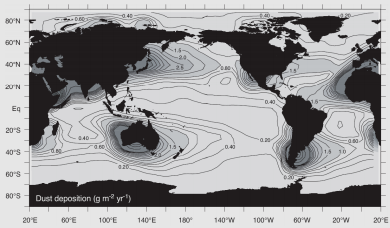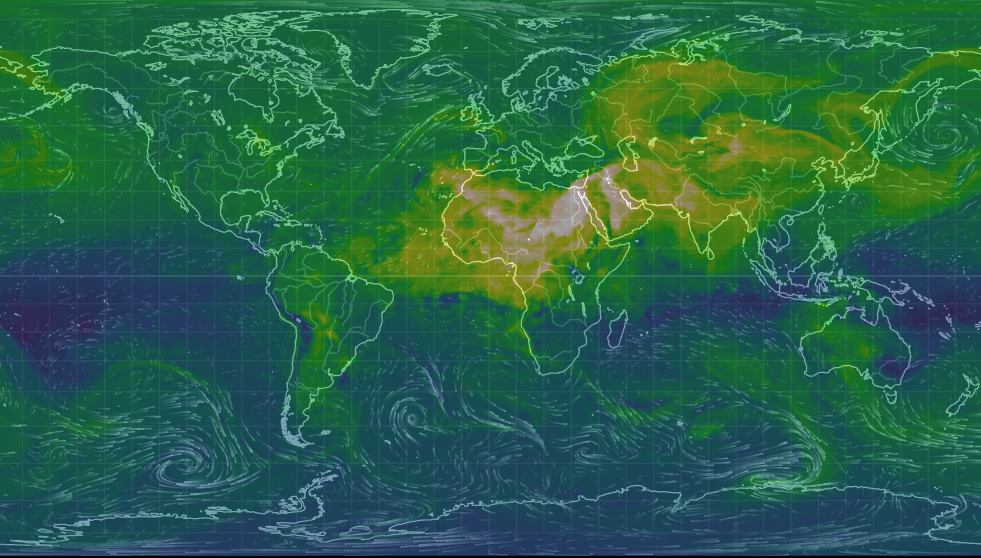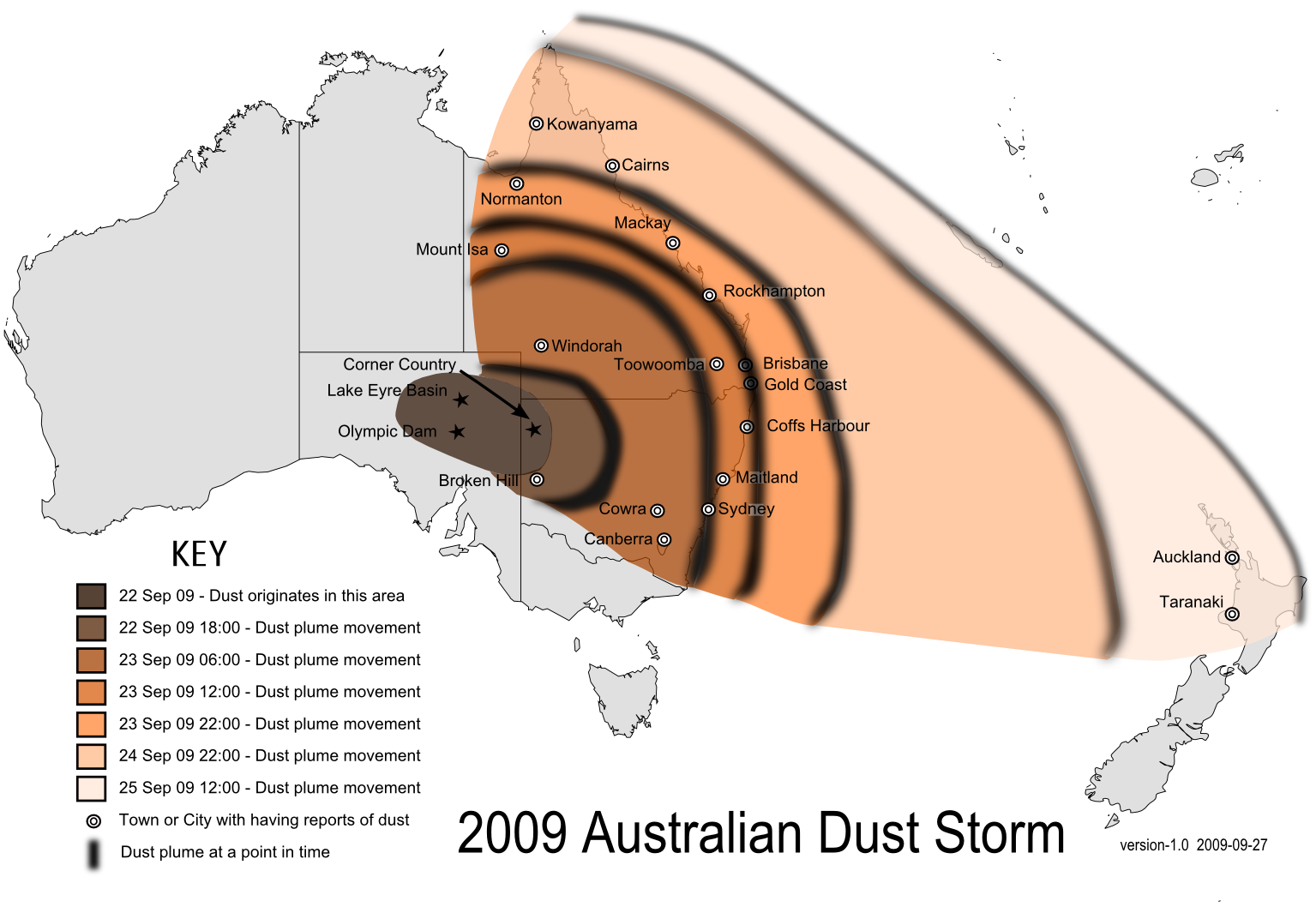|
Bull Dust
Bulldust or bull dust is a fine, soft and powdery red aeolian dust that is common across Australia, especially in the Outback and desert. Bulldust is a type of fugitive dust that when disturbed can have dangerous effects. Bulldust is common on remote roads, especially in the far north of Australia where the wet and dry season can cause the roads to either be boggy or very dry. Bulldust is also an Australian colloquial term and euphemism. Both meanings of the term originated in the 1920s. Causes and general description Most soils in Australia have no structure, and their surface often contains medium to high amounts of fine sand. Because of the lack of structure when compressed or disturbed, bulldust will form. These disturbances can be anything that breaks up the track surface, such as a car or vehicle driving along a road, or a pack of animals such as camels running through the desert. Once the road surface has been disturbed, the bulldust particles released into the air can ... [...More Info...] [...Related Items...] OR: [Wikipedia] [Google] [Baidu] |
Aeolian Dust
Dust is made of fine particles of solid matter. On Earth, it generally consists of particles in the atmosphere that come from various sources such as soil lifted by wind (an aeolian process), volcanic eruptions, and pollution. Dust in homes is composed of about 20–50% dead skin cells. The rest, and in offices, and other human environments is composed of small amounts of plant pollen, human hairs, animal fur, textile fibers, paper fibers, minerals from outdoor soil, burnt meteorite particles, and many other materials which may be found in the local environment. Atmospheric Atmospheric or wind-borne fugitive dust, also known as ''aeolian dust'', comes from arid and dry regions where high velocity winds are able to remove mostly silt-sized material, deflating susceptible surfaces. This includes areas where grazing, ploughing, vehicle use, and other human behaviors have further destabilized the land, though not all source areas have been largely affected by anthropogenic ... [...More Info...] [...Related Items...] OR: [Wikipedia] [Google] [Baidu] |
Outback
The Outback is a remote, vast, sparsely populated area of Australia. The Outback is more remote than the bush. While often envisaged as being arid, the Outback regions extend from the northern to southern Australian coastlines and encompass a number of climatic zones, including tropical and monsoonal climates in northern areas, arid areas in the "red centre" and semi-arid and temperate climates in southerly regions. Geographically, the Outback is unified by a combination of factors, most notably a low human population density, a largely intact natural environment and, in many places, low-intensity land uses, such as pastoralism (livestock grazing) in which production is reliant on the natural environment. The Outback is deeply ingrained in Australian heritage, history and folklore. In Australian art the subject of the Outback has been vogue, particularly in the 1940s. In 2009, as part of the Q150 celebrations, the Queensland Outback was announced as one of the Q150 Icons of Q ... [...More Info...] [...Related Items...] OR: [Wikipedia] [Google] [Baidu] |
Bulldust
Bulldust or bull dust is a fine, soft and powdery red aeolian dust that is common across Australia, especially in the Outback and desert. Bulldust is a type of fugitive dust that when disturbed can have dangerous effects. Bulldust is common on remote roads, especially in the far north of Australia where the wet and dry season can cause the roads to either be boggy or very dry. Bulldust is also an Australian colloquial term and euphemism. Both meanings of the term originated in the 1920s. Causes and general description Most soils in Australia have no structure, and their surface often contains medium to high amounts of fine sand. Because of the lack of structure when compressed or disturbed, bulldust will form. These disturbances can be anything that breaks up the track surface, such as a car or vehicle driving along a road, or a pack of animals such as camels running through the desert. Once the road surface has been disturbed, the bulldust particles released into the air can ... [...More Info...] [...Related Items...] OR: [Wikipedia] [Google] [Baidu] |
Dust In The Track
Dust is made of particle size, fine particles of solid matter. On Earth, it generally consists of particles in the atmosphere that come from various sources such as soil lifted by wind (an aeolian processes, aeolian process), Types of volcanic eruptions, volcanic eruptions, and pollution. Dust in homes is composed of about 20–50% dead skin Cell (biology), cells. The rest, and in offices, and other built environment, human environments is composed of small amounts of plant pollen, human hairs, animal fur, textile fibers, paper fibers, minerals from outdoor soil, burnt meteorite particles, and many other materials which may be found in the local environment. Atmospheric Atmospheric or wind-borne fugitive dust, also known as ''aeolian dust'', comes from arid and dry regions where high velocity winds are able to remove mostly silt-sized material, deflating susceptible surfaces. This includes areas where grazing, ploughing, vehicle use, and other human behaviors have further ... [...More Info...] [...Related Items...] OR: [Wikipedia] [Google] [Baidu] |
Pounds Per Square Inch
The pound per square inch or, more accurately, pound-force per square inch (symbol: lbf/in2; abbreviation: psi) is a unit of pressure or of stress based on avoirdupois units. It is the pressure resulting from a force of one pound-force applied to an area of one square inch. In SI units, 1 psi is approximately equal to 6895 Pa. Pounds per square inch absolute (psia) is used to make it clear that the pressure is relative to a vacuum rather than the ambient atmospheric pressure. Since atmospheric pressure at sea level is around , this will be added to any pressure reading made in air at sea level. The converse is pounds per square inch gauge (psig), indicating that the pressure is relative to atmospheric pressure. For example, a bicycle tire pumped up to 65 psig in a local atmospheric pressure at sea level (14.7 psi) will have a pressure of 79.7 psia (14.7 psi + 65 psi). When gauge pressure is referenced to something other than ambient atmospheric pressure, then the u ... [...More Info...] [...Related Items...] OR: [Wikipedia] [Google] [Baidu] |
Four-wheel Drive
Four-wheel drive, also called 4×4 ("four by four") or 4WD, refers to a two-axled vehicle drivetrain capable of providing torque to all of its wheels simultaneously. It may be full-time or on-demand, and is typically linked via a transfer case providing an additional output drive shaft and, in many instances, additional gear ranges. A four-wheel drive vehicle with torque supplied to both axles is described as "all-wheel drive" (AWD). However, "four-wheel drive" typically refers to a set of specific components and functions, and intended off-road application, which generally complies with modern use of the terminology. Definitions Four-wheel-drive systems were developed in many different markets and used in many different vehicle platforms. There is no universally accepted set of terminology that describes the various architectures and functions. The terms used by various manufacturers often reflect marketing rather than engineering considerations or significant technical diff ... [...More Info...] [...Related Items...] OR: [Wikipedia] [Google] [Baidu] |
Bullshit
''Bullshit'' (also ''bullshite'' or ''bullcrap'') is a common English expletive which may be shortened to the euphemism ''bull'' or the initialism B.S. In British English, "bollocks" is a comparable expletive. It is mostly a slang term and a profanity which means "nonsense", especially as a rebuke in response to communication or actions viewed as deceptive, misleading, disingenuous, unfair or false. As with many expletives, the term can be used as an interjection, or as many other parts of speech, and can carry a wide variety of meanings. A person who excels at communicating nonsense on a given subject is sometimes referred to as a "bullshit artist" instead of a "liar." In philosophy and psychology of cognition the term "bullshit" is sometimes used to specifically refer to statements produced without particular concern of truth, to distinguish from a deliberate, manipulative lie intended to subvert the truth. [...More Info...] [...Related Items...] OR: [Wikipedia] [Google] [Baidu] |
Fugitive Dust
Fugitive dust is an environmental air quality term for very small particles suspended in the air, primarily mineral dust that is sourced from the soil of Earth's pedosphere. A significant volume of fugitive dust that is visible from a distance is known as a ''dust cloud'', and a large dust cloud driven by a gust front is known as a dust storm. Fugitive dust particles are mainly minerals common to soil, including silicon oxides, aluminium oxides, calcium carbonates and iron oxides. About half of fugitive dust particles are larger than 10 microns in diameter and settle more quickly than the smaller particles. It does not include particulate matter from other common artificial sources such as vehicle exhaust, burn piles or smokestacks. The term is used to denote that the dust "escapes" into the atmosphere rather than being exhausted in a "confined flow stream" from a "ducted emitter" (an exhaust pipe or chimney). The U.S. Environmental Protection Agency estimated that fugitiv ... [...More Info...] [...Related Items...] OR: [Wikipedia] [Google] [Baidu] |
Dust
Dust is made of fine particles of solid matter. On Earth, it generally consists of particles in the atmosphere that come from various sources such as soil lifted by wind (an aeolian process), volcanic eruptions, and pollution. Dust in homes is composed of about 20–50% dead skin cells. The rest, and in offices, and other human environments is composed of small amounts of plant pollen, human hairs, animal fur, textile fibers, paper fibers, minerals from outdoor soil, burnt meteorite particles, and many other materials which may be found in the local environment. Atmospheric Atmospheric or wind-borne fugitive dust, also known as ''aeolian dust'', comes from arid and dry regions where high velocity winds are able to remove mostly silt-sized material, deflating susceptible surfaces. This includes areas where grazing, ploughing, vehicle use, and other human behaviors have further destabilized the land, though not all source areas have been largely affected by anthropogenic ... [...More Info...] [...Related Items...] OR: [Wikipedia] [Google] [Baidu] |
2009 Australian Dust Storm
The 2009 Australian dust storm, also known as the Eastern Australian dust storm, was a dust storm that swept across the Australian states of New South Wales and Queensland from 22 to 24 September 2009. The capital, Canberra, experienced the dust storm on 22 September, and on 23 September the storm reached Sydney and Brisbane. Some of the thousands of tons of dirt and soil lifted in the dust storm were dumped in Sydney Harbour and the Tasman Sea. On 23 September, the dust plume measured more than in width and in length and covered dozens of towns and cities in two states. By 24 September, analysis using MODIS at NASA measured the distance from the northern edge at Cape York to the southern edge of the plume to be 3,450 km. While the cloud was visible from space, on the ground the intense red-orange colour and drop in temperature drew comparisons with nuclear winter, Armageddon, and the planet Mars. The dust storm was described by the Bureau of Meteorology as a "pretty inc ... [...More Info...] [...Related Items...] OR: [Wikipedia] [Google] [Baidu] |
Manchester University Press
Manchester University Press is the university press of the University of Manchester, England and a publisher of academic books and journals. Manchester University Press has developed into an international publisher. It maintains its links with the University. Publishing Manchester University Press publishes monographs and textbooks for academic teaching in higher education. In 2012 it was producing about 145 new books annually and managed a number of journals. Areas of expertise are history, politics and international law, literature and theatre studies, and visual culture. MUP books are marketed and distributed by Oxford University Press in the United States and Canada, and in Australia by Footprint Books; all other global territories are covered from Manchester itself. Some of the press's books were formerly published in the US by Barnes & Noble, Inc., New York. Later the press established an American office in Dover, New Hampshire. Open access Manchester University Pre ... [...More Info...] [...Related Items...] OR: [Wikipedia] [Google] [Baidu] |






.jpg)


